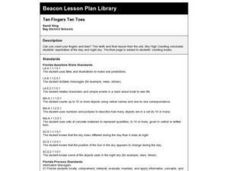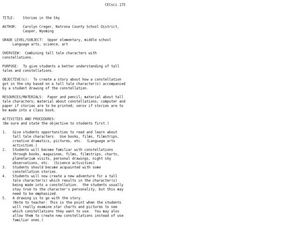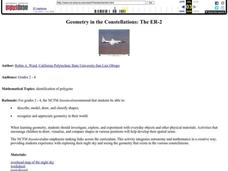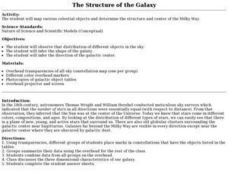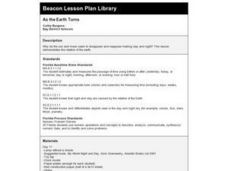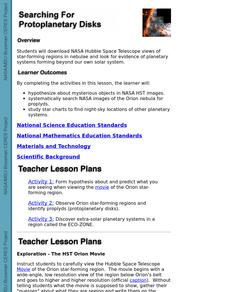Curated OER
Exploring the Constellations, a WebQuest Activity
Students explore space science by participating in a class WebQuest. In this constellation identification lesson, students view star charts based on the four seasons and identify the changes our sky goes through in the course of 12...
Curated OER
Planetarium- Identifying Constellations
Students explore the planetarium. In this space science lesson, students identify the different constellations in the sky. They make their own map of the constellations.
Curated OER
Scavenger Hunt
Young scholars study a research telescope to obtain quantitative information about these objects. They use the SkyServer Navigation Tool to identify objects and record celestial coordinates. In addition, they associate star brightness...
International Technology Education Association
Singin' the Black and Blues
How does the color of the sky change from blue to reds and oranges to black? An illuminating lesson explains how light travels through different mediums using the sun's light as an example. By examining diagrams and illustrations, pupils...
Weber State University
The Sun and the Seasons
Why is there more daylight in June than in December if you live above the equator? How does the angle of sunlight shift throughout the year? Answer these questions and more with an interactive article about the sun, its path through the...
St. Aidens Homeschool
Rejoice Christ is Born
Learn the story of the birth of Jesus Christ with a nativity lesson. The resource provides everything you need to create a file folder nativity scene, coloring book, mini book, and construction paper North Star.
Curated OER
Ten Fingers Ten Toes
First graders identify the number 10 by completing a page for a counting book. They add the page to the first nine pages.
Curated OER
Constellations
Students explore the major constellations. After reviewing the Earth's basic motions and their significance, students discuss the moon's orbit and revolutions. Using a Digitarium Alpha portable planetarium projector, they observe at...
Curated OER
A DISAPPEARING ACT Astronomy: Do Stars Always Shine?
Students observe why stars are not visible during the day with a classroom demonstration using an index card punched with holes.
Curated OER
Stellar Magnitudes
Middle schoolers analyze the stellar magnitude scale. In this stellar magnitude lesson, students examine the stellar magnitude scale. Middle schoolers predict the Sun's magnitude from various planets.
Curated OER
Constellations
Fifth graders create their own constellations using pin holes and black paper. In this space science lesson, 5th graders write a story about their constellation. They share their project with the class.
Curated OER
Stories in the Sky
Students discover the concept of combining constellations and tall tales. In this tall tale lesson, students compare constellations to tale tales. They create their own tall tale and constellation.
Curated OER
Astronomy Unit: For Autistic Learners
In need of a few great ways to teach an arts-enriched lesson on astronomy? This resource contains several interesting ideas that link poetry to the stars in the sky. These suggestions are very simple and could use a teachers touch, but...
Curated OER
Geometry in the Constellations: The ER-2
Students discuss reasons to record the location of stars. They view a picture of the night sky, and discuss constellations. Students complete a worksheet of the various shapes they see in the constellations.
Curated OER
Hot Air
Students conduct an experiment to determine how hot air affect the path of laser. In this physics lesson, students explain why stars appear to twinkle at night. They discuss how light travels from space to Earth.
Curated OER
Bouncing Sunlight
Third graders use flashlights and balls to demonstrate how the light bounces off of the sun and reflects onto the moon. They record their observations in a journal.
Curated OER
Mystery Constellations
Fourth graders predict constellations each month. In this astronomy instructional activity, 4th graders are presented with two constellations every month, and guess what they are as clues are given.
Curated OER
Guess How Many: Estimation Practice
In this estimation activity, students estimate the number of stars in a picture, explain how they estimated and count the actual stars. Students then draw their own picture and have a classmate estimate stars.
Curated OER
The Structure of the Galaxy
Learners infer the galaxy shape. In this structure of the galaxy lesson students observe the distribution of objects in the sky and answer questions.
Curated OER
Seeing Interference Fringes with a Telescope
Students construct an interferometer using a simple telescope. In this physics lesson, students explain how light waves create the fringe patterns. They observe patterns made by different objects in the sky and compare them.
Curated OER
As the Earth Turns
First graders explore why the sun and moon seems to disappear and reappear creating day and night.
Curated OER
Searching For Protoplanetary Disks
Students download NASA Hubble Space Telescope views of star-forming regions in nebulae and look for evidence of planetary systems forming beyond our own solar system. They hypothesize about mysterious objects in NASA HST images.
Curated OER
Space Science: Zodiac Track
Students create posters of the constellations using glow-in-the-dark glue and black paper. They hang their posters around the room starting with Aries and moving through all the signs. Students create a jingle or acronym to help them...
Curated OER
Mother Earth - Father Sky
Third graders research and write about Cyrus Dillan. They explain one of Dillan's sculptures. Students locate six constellations and two planets. They research and write about the daily life of the Pawnee.








